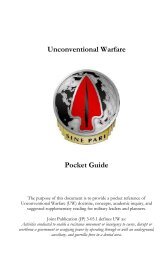ED077712
ED077712
ED077712
You also want an ePaper? Increase the reach of your titles
YUMPU automatically turns print PDFs into web optimized ePapers that Google loves.
From Numerals to Computation 29<br />
used in the shops and banks "counters," and this name has since<br />
been commonly used for the bench on which goods are shown in<br />
stores. The expression "counting house" is still used in some<br />
places to designate the room in which accounts are kept.<br />
One reason for using the counters was that paper was not generally<br />
known in Europe until about the eleventh century. Boards<br />
covered with a thin coat of wax had been used from the time of<br />
the Greeks and Romans, more than a thousand years before.<br />
On these it was possible to scratch numbers and words, erasing<br />
them by smoothing the wax with a spoon-shaped eraser, but it<br />
was very slow work. Slates were used in some parts of Europe,<br />
but usable slate quarries were not common and therefore slates<br />
could not readily be used elsewhere.<br />
When blackboards were first made, chalk was not always easily<br />
found, and so written addition was not so common as addition by<br />
counters. When slates, blackboards, and paper all came into use,<br />
people added about as we do now. Since all careful computers<br />
"check" their work by adding from the bottom up and then from<br />
the top down so as to find any mistakes, pupils today add both<br />
ways, and there is no reason for teaching addition in only one<br />
direction.<br />
Subtraction was done on the counting boards in much the same<br />
way as addition. The numbers were represented by counters and<br />
were taken-away as the problem required. The terms "carry"<br />
and "borrow" had more meaning than at present, because a<br />
counter was actually lifted up and carried to the next place. If<br />
one was borrowed from the next place, it was actually paid back.<br />
Today we learn the-multiplication facts just as we learn 0 read<br />
words. If we need to use 7 x 8, we simply think "56," just as we<br />
think "cat" when we see the word CAT. Formerly, however, the<br />
"multiplication table" was first written down and then learned as<br />
a whole. On the following page are two of these tables from one<br />
of the oldest printed arithmetics, a German book of 1489 by<br />
Johann Widman. You may wish to see how they were arranged<br />
and how to find, in each table, the product of 8 X 9.<br />
You may also like to see how multiplication looked in 1478, and





